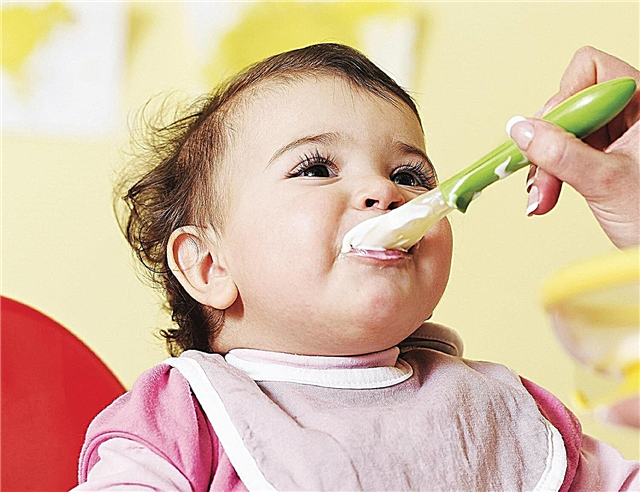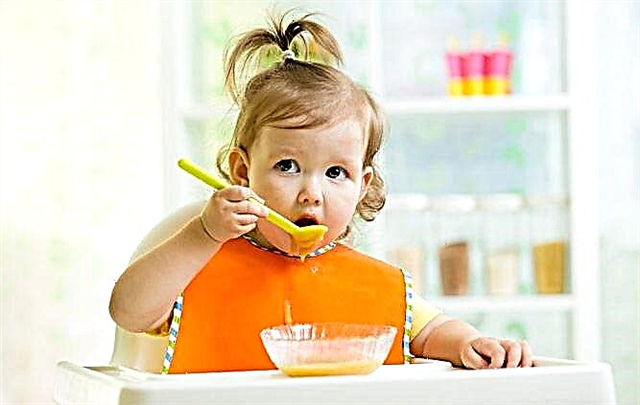
Vegetable puree for babies as a complementary food is recommended first of all. Not juices or cereals, as some parents think, but vegetables. They are rich in vitamins and minerals, they have enough dietary fiber, which will provide the child with soft and delicate digestion and will be a good prevention of constipation.
In this article, we will talk about how to introduce vegetable complementary foods, how to make tasty and healthy puree for babies, what vegetables to give and in what quantity.
What vegetables does the first feeding start with?
Breast milk and milk adapted formulas meet the requirements of the child for about the first six months of life. Then the baby's diet should expand. Pediatricians recommend vegetable purees to be introduced into the diet in the first place... But not all vegetables are permissible for starting a baby's acquaintance with new food.
It is recommended to start introducing vegetables with mashed potatoes. However, it must be prepared from hypoallergenic vegetables.

If the child is breastfed, it is recommended to introduce vegetable complementary foods from 5-6 months. For a child who, by coincidence, is deprived of breast milk and eats formula, it is better to introduce vegetables into the diet at 4 months of age.
It is recommended to introduce vegetables in a certain sequence. For the very first experience of a new food vegetables are recommended that usually do not cause allergies, the so-called low-allergenic. These are zucchini, broccoli and cauliflower. In this case, the first baby vegetable puree must necessarily be one-component, that is, contain only one type of vegetable crop - only squash or only mashed cauliflower.
Further, the vegetable diet is expanded due to products of medium allergenicity. About a month after the introduction of complementary foods, you can give vegetables from this list in order:
- pumpkin;
- carrot;
- potatoes;
- squash.
A month later, at the age of 7-8 months, add cabbage, beets and cucumbers, a year - tomatoes, and at 1.5 years - beans, peas and other legumes. It is recommended to introduce eggplants after one and a half years, closer to 2 years.


Manufacturer rating
Ready-made baby puree in a jar is convenient and safe. Manufacturers make sure that the composition of the product is hypoallergenic and balanced. To start, feeding puree in a jar is the most optimal option, because it is inappropriate to cook homemade puree for the sake of half a teaspoon that the baby will eat. In addition, it is convenient to take mashed potatoes in a jar with you for a walk, on a trip.
Choosing a particular brand of baby food is a matter of income and family preferences. The pediatrician can only recommend certain manufacturers, but the parents will still choose themselves, taking into account the preferences of their own baby, because it happens that a child refuses to eat mashed potatoes of one brand, and he is delighted with the same mashed potatoes, but from another manufacturer.
The rating of manufacturers of baby vegetable puree is based on several criteria:
- safety and risk of product allergy;
- taste qualities;
- reviews of parents and pediatricians.

According to these three criteria, existing brands can be arranged in the following order:
- Humana;
- Gerber;
- "Grandma's basket";
- Nutricia;
- "FrutoNyanya";
- "Topic";
- "Diaper";
- "Agusha";
- Hipp.
When choosing ready-made puree, be sure to pay attention to the age marking, for the expiration date. If the jar does not emit cotton when you open it, you cannot feed the baby with such mashed potatoes. If you wish, you can make vegetable puree yourself, but a number of important conditions must be met.


Selection and preparation of ingredients
To make homemade vegetable puree that can be fed to a baby, you need to choose only fresh vegetables, the appearance of which is not satisfactory... If the zucchini or pumpkin have darkening, unevenness, areas of rot, cracks, "damaged" sides, they are not suitable for baby food.
You can buy vegetables in the market, in the store, but the best option are fruits and roots harvested on your site... If there is no dacha and vegetable garden, choose only those purchased that are grown in your strip. Imported and imported vegetables and fruits are usually packed with a lot of chemicals to keep them in a marketable condition. You need to be especially careful about the choice of vegetables if they are out of season in your strip. Instead of a purchased zucchini in the middle of winter, it is better to buy ready-made puree in a jar from a trusted manufacturer of baby food.
You should not select vegetables for baby puree, the sides of which are shiny - it is possible to use wax, with which vegetables are rubbed to retain moisture when transported from afar.


Home cooking recipes
Making mashed potatoes is easy. The task will be facilitated by the presence of a blender and a double boiler in the kitchen. You can also get good mashed potatoes in a slow cooker. To make a one-part puree for the first feeding, take the courgette, wash it well and peel it. Cut the vegetable into large pieces, after removing the seeds and core.
If you cook vegetables in small pieces, they will hardly retain nutrients during heat treatment.
Place the zucchini chunks in a multicooker bowl, double boiler, or small saucepan with a little water. Bring under the lid until tender. Use a blender to mash the boiled zucchini. If it turns out to be thick, add a little vegetable broth that remained after heat treatment, or boiled water. It is not recommended to salt and pepper the vegetable puree for infants.but you can add a few drops of extra virgin olive oil. Prepared puree is not stored... Before the next feeding, which provides for supplementary feeding with vegetables, it is re-cooked.
After 8 months, the child will be able to eat multicomponent purees... In this case, you can immediately cook several types of vegetables in the same way, and then make a single puree out of them. Zucchini and carrots, zucchini and broccoli, cauliflower and carrots, beets and carrots go well with each other. Almost all types of vegetables go well with mashed potatoes, which is prepared in the same way, but with the addition of milk or water (with the permission of the pediatrician), without butter. As the baby grows, you can create mashed soups and vegetable mousses, for example, from boiled pumpkin and cottage cheese, from zucchini and boiled carrots, on the basis of ordinary vegetable purees.


Norms and rules of use
Complementary feeding always starts with a minimum amount of new product. For a kid, acquaintance with vegetables should begin with half a teaspoon.... During the day, the mother must carefully observe the baby. If allergies, intestinal disorders do not appear, the next day you can increase the amount of vegetable puree to a teaspoon.
The infant feeding scheme does not involve adding more than one new product every two days. It is important to keep track of possible negative reactions of the child's body to food. It will be useful for the baby and his parents if the amount of complementary foods meets the standards.
A table indicating the minimum and maximum value of the amount of vegetable puree allowed at a given age will help to determine them.
The table shows the daily value. Parents can break this amount into two or three meals if the child likes vegetables. Thus, a child at 5 months can be given vegetables twice a day, 15 grams per feeding, and at 6 months, you can give two times 25 grams.


Before one year old, it is important to teach a child to eat vegetables.otherwise, later, at an older age, the baby may refuse to eat these useful and necessary foods and dishes for his growth and development. But only in theory, children should eat this or that amount of food. In practice, everything may not work out so - the child will require vegetables more often and more, or refuse them altogether. With the latter problem, parents most often turn to pediatricians.

What if the child does not want to eat mashed potatoes?
A child who does not want to eat vegetable puree at his tender age has many reasons for this behavior.
Here are just some of the reasons why children refuse this dish.
- Complementary foods are introduced too early, the child is psychologically and physiologically not ready for it - you need to postpone the venture and return to it in a week.
- The child does not like the taste of vegetables - try another vegetable. If you don't eat zucchini, give broccoli, if you refuse to buy store-bought mashed potatoes in a jar, cook it at home.
- The type of vegetables is incomprehensible or unpleasant - put your child more often in a high chair at an adult table during dinner or breakfast, he should see how adults eat their food. This will form an idea of why mom even sticks to him with a spoon and a strange substance in a plate or jar. Serve mashed potatoes in a beautiful children's plate, use an interesting spoon with animal figurines, keep your baby interested in the process of eating.
- The child is not up to vegetables - he has teething or a stomach ache, he gets sick. In this situation, it is impossible to offer new products, so as not to increase the load on the baby's body.
- The kid is not hungry - in this situation, wait until the child is hungry and offer the vegetable puree at the very beginning of the meal.
- There is already a negative experience - if the baby was forced to eat vegetables, a spoon was pushed into him by force, the taste of mashed potatoes will be unpleasant for quite understandable psychological reasons. In this situation, give the child the opportunity to choose for themselves whether to eat or not. And vegetables that are so needed can be mixed into other types of food, for example, in vegetable puree soup, in porridge.


In order to prevent situations in which the child will hate vegetable dishes, it is important to do everything on time. Do not blindly follow the advice of relatives and pediatricians about the timing of complementary foods. If a child once in his six months gave up zucchini, no need to insist. Try to offer him complementary foods a little later.... All children develop at different rates and according to their own schedule. This applies not only to height and weight, but also metabolic processes, the processes of production of necessary enzymes in the body, because without them the assimilation of new food is impossible.
The same recommendation applies to the amount of vegetables eaten. The child owes nothing to anyone. He may well have his own tastes and needs for the amount of complementary foods. And not always his real needs exactly correspond to pediatric norms and tables.
For information on how to cook vegetable puree at home for a 7-8 month old child, see the next video.
Find out if your child's weight is normal using the following calculator.



